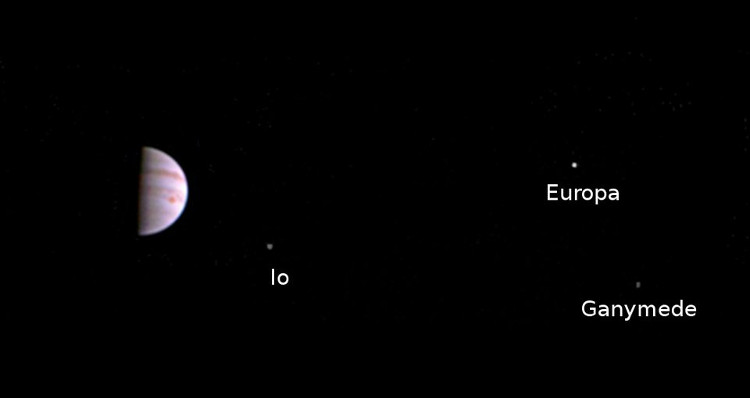The Juno probe sends the first image of Jupiter to Earth
More than a week after entering Jupiter (or Jupiter), NASA's Juno spacecraft sent the first image it captured back to Earth. At a distance of more than 4.3 million kilometers, the JunoCam camera equipped with the ship captures a picture showing a giant red spot of the famous Great Red Spot , as well as three of the planet's four largest moons, including : Io, Europa and Ganymede. Jupiter's second largest moon, Callisto, is not within the camera's view.
While the high-resolution images of the giant gas named Jupiter took several weeks to reach the ground, the scientists showed great satisfaction with the first image recorded."Photographs from JunoCam show that the device survived in Jupiter's extreme radiation environment. It was not damaged and ready to photograph Jupiter," said Scott Bolton, research leader at the Institute of Research. Rescue Southwest in San Antonio (USA), said.

Photograph of Jupiter that Juno ship sent to Earth.
The Juno spacecraft is currently moving around Jupiter on a large arc-shaped trajectory, but will approach closer to the planet's surface again in August, allowing JunoCam to take a closer picture.
Juno was launched into space in 2011, the second spacecraft to enter Jupiter orbit after Galileo - the unmanned spacecraft that orbited the planet in 1995-2003. After 5 years of tireless travel, with a distance of up to 2.8 billion km, Juno was finally able to enter Jupiter's orbit on July 5 last.
The goal of Juno is to help scientists better understand the largest planet in our Solar System, and also the fifth planet from the Sun. The Juno mission will end in 2018, when the spacecraft hits the planet's surface, ensuring it will not cause any damage to Jupiter's moons.
- Juno Jupiter probe flies close to Earth
- NASA published a detailed photograph of Jupiter's southernmost surface sent by Juno
- The Juno probe successfully approached super typhoon on Jupiter
- Juno spacecraft completes halfway to Jupiter
- A series of wonderful images of Jupiter are sent from the Juno-NASA ship
- NASA's billion-dollar probe began to fall freely into Jupiter
- Juno spacecraft straightens Jupiter
- The Juno ship first approached Jupiter since flying into orbit
- Jupiter once swallowed 10 times the planet Earth
- NASA's Juno spacecraft is about to approach Jupiter on July 4
- NASA announces super-stormy image of Big Red Spot on Jupiter
- A beautiful Jupiter Jupiter under the view of the Juno ship
 Van Allen's belt and evidence that the Apollo 11 mission to the Moon was myth
Van Allen's belt and evidence that the Apollo 11 mission to the Moon was myth The levels of civilization in the universe (Kardashev scale)
The levels of civilization in the universe (Kardashev scale) Today Mars, the sun and the Earth are aligned
Today Mars, the sun and the Earth are aligned The Amazon owner announced a secret plan to build a space base for thousands of people
The Amazon owner announced a secret plan to build a space base for thousands of people